|
20. Colias crocea (Fourcroy, 1758) / Clouded yellow / Pieridae – Coliadinae
NL: oranje luzernevlinder / D: Wander-Gelbling, Postillon / F: souci
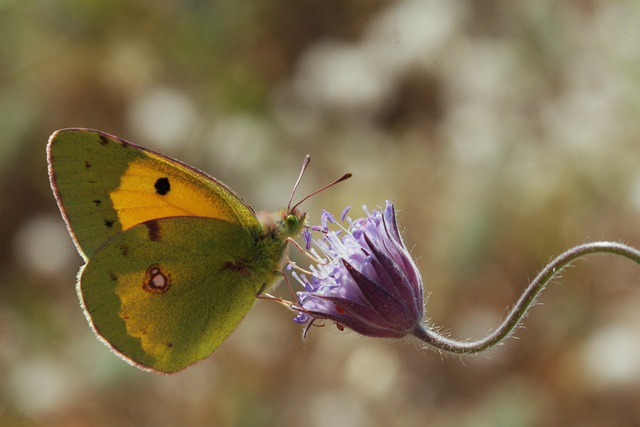 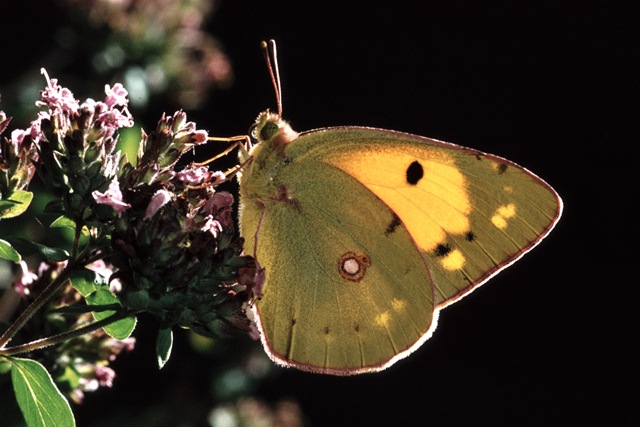 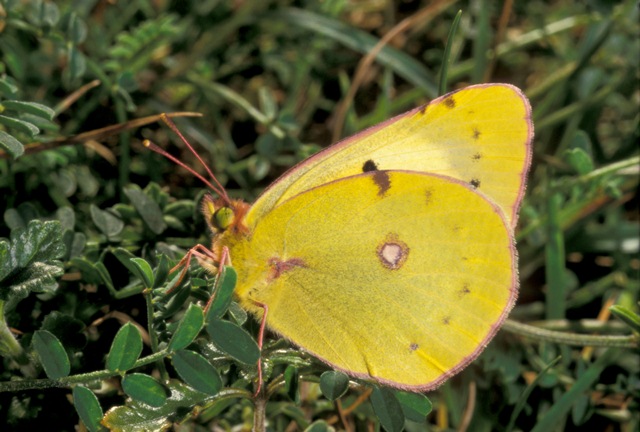
Photographs: Jeroen Voogd ©, Frits Bink ©, Frits Bink ©.
Medium sized or large, wing length 25 (22-27) mm. In the Benelux the butterfly occurs irregularly by invasion. The last invasion occurred in the Netherlands in the summer of 2013 and, because of the very mild 2013/14 winter, butterflies were seen in early summer 2014, obviously survivors of the offspring of the immigrants.
Butterfly is on the wing in the Benelux from early-May until late-October, peaking in mid-August. The species is present permanently in warm maritime and mild continental climates, amplitude 4 up to 10, where the heat sum is at least 2300°d and not more than 3300°d and the average temperature of the coldest month more than 8°C. The corresponding climate windows are 41 weeks and whole year open.
In summertime the immigrants in the temperate zone can reproduce when heat sum is at least 750°d and the climate window 24 weeks, but all the offspring of these migrants will perish in wintertime.
The southward flight in the autumn is seldom observed, however in warmer climates it is a common phenomenon. (In this way the species is comparable with Vanessa cardui). In the temperate climate zone the species is a vagrant but in the Mediterranean zone a nomad. It is a specialist that looks for vegetation on bare soil where seeds germinate and herbs develop new growth; thus this species is well adapted for life in arable fields where after ploughing, burning or mowing there will be an ideal period for oviposition. When alfalfa blooms, it provides an excellent nectar source and clouds of butterflies may be seen in the fields, which after harvesting provide good conditions for oviposition.
Ecological characteristics
Behaviour over time
Overwintering: continuously brooded, without a diapause, the larva feeds during frost free periods and survives in places where the average temperature of the coldest month is above 8°C. The overwintering larva makes one moult extra, so there are 6 larval stages instead of 5.
Reproduction: oviposition starts after 9-12 days when the body contains 140 (120-178) eggs. Estimated potential reproduction 3.6 times as much. The butterfly hatches without any trace of eggs in the body and during migration egg development is suppressed.
Larval feeding periods: the whole year.
Generations: in the temperate climate zone usually one, in warm summers two is possible.
Spreading of risk: because of its nomadic or migratory lifestyle, the species has many possibilities to escape from threats.
Life cycle: egg 5 (4-7) days; larva in summer 26 (19-37) days, in winter 16-20 weeks; pupa 11 (8-15) days.
Life span of adult: long, up to 5 weeks.
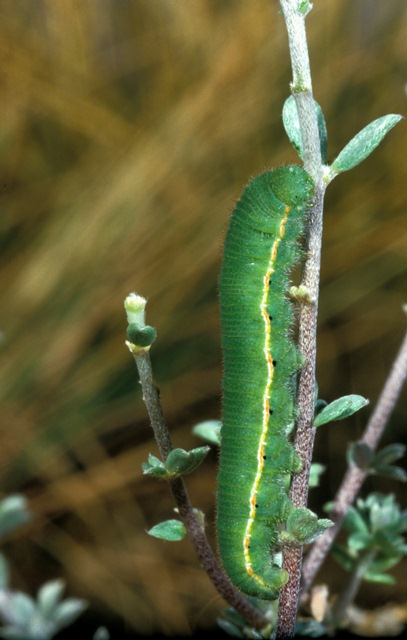 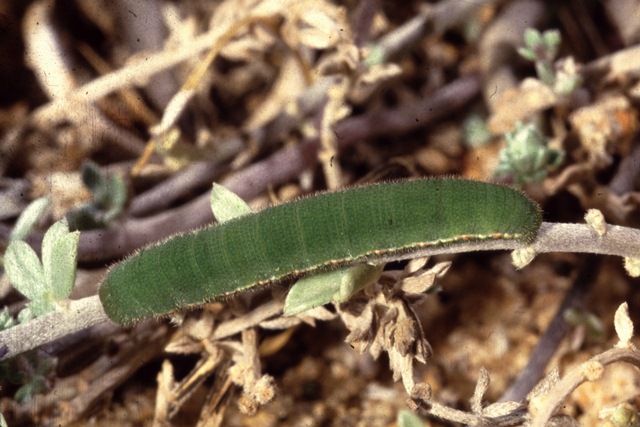
Photographs: Frits Bink ©.
Behaviour in space
From stay-at-home to migrant: nomad, in temperate climate zone a vagrant.
Finding a mate: sexes meeting each other in localities rich in flowers.
Orientation in the landscape: during migration seashore, river banks, during oviposition places with bare ground where seedlings or sprouting host-plants are present.
Oviposition: preference for very young plant, even the cotyledon.
Defence
Threats from other organisms: no special defence, the butterfly is ignored by avian predators.
Threats from the environment: both larva and adult resist heat and cold (but see above).
Feeding habits
Adult: nectar of all kind of flowers, well known visitors of flowering alfalfa and clover fields.
Larva: has no preference for young or old leaves.
Larval foodplants
Plant species: Fabaceae, preference for herbs with prostrate growth, e.g. Hippocrepis comosa, Lupinus luteus, Medicago arabica, M. sativa, Securigera varia, Trifolium pratense.
Journal
Rearing experiments based on specimens from Port Royan, France:
28 August 1984: old female captured.
29 August: eggs laid.
6 October: first larva is pupating.
25 October: four pupae hatch.
27 October: pair in copula.
1 November: egg load examination by dissection (see table 20-1).
Rearing experiment based on specimen from Quarteira, Portugal:
23 November 1985: old female captured.
23 November: egg laid.
28 November: egg hatched, larva put on Securigera varia.
30 November: larva ate only old leaf and refused young sprouts.
5 December: in moult L1-2.
10 December: larva placed on Lotus cretica, because leaves of this plant persist in wintertime.
22 December: in moult L2-3.
28 January 1986: in moult L3-4.
15 February: in moult L4-5.
27 February: in moult L5-6, 12 mm in length.
16 March: larva wandering to find suitable pupation site.
19 March: pupated.
3 April: female hatched, f. helice.
Table 20-1. Results of dissections

Table 20-2. Collection and observation localities
E, Las Negras 36° 52’N – 2° 00’W; 20 February 2005.
E, Salinas 37° 36’ 08”N – 0° 43’ 47”W; 10 February 2005.
F, Brittany, Telgruc-sur- Mer 48° 12’ 25”N – 4° 22’ 25”W; 29 September 2004.
F, Cap Blanc-Nez 30 m, 50° 55’ 37”N – 1° 42’45”E; 10 June 2000.
F, la Grande Brière 47° 23’ 42”N – 2° 17’ 22”W; 24 September 2004.
F, Normandy, Havre de Surville 49° 16’ 47”N – 1° 40’ 23”W; 19 September 2005.
GR, Rhodos 36° 12’N – 28° 04’W; 17 April 1990.
NL, Bennekom garden 51° 59’ 33”N – 5° 40’ 52”E; 27 August 2013.
NL, Herreveld 51° 54’ 27”N – 5° 44’’ 23”E; 17 July 2014.
NL, Kortgene 51° 34’N – 3° 48’E; 20 September 2003.
NL, Randwijk 51° 57’ 19”N – 5° 42’ 08”E; 31 July 2013.
NL, Wageningen 51° 59’ 13”N – 5° 41’ 05”E; 27 October 2013.
NL, Nunspeet; 7 August 1983 (one female by Nico Elfferich, ‘16 August’ in table 20-1).
P, Quarteira 37° 04’ 48”N – 8° 08’ 46”W; 10 November 1985.
P, Quarteire 37° 03’ 45”N – 8° 04’ 20”W; 21 November 1985.
Fig. 20-1. Colias crocea, phenogram adapted from Fichefet et al. 2008: 77.
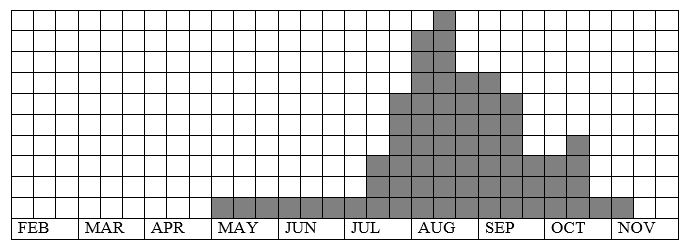
Fig. 20-2. Colias crocea, habitat characteristics.

Fig. 20-3. Colias crocea, climate matrix, heat-sums summer season 750 - 3300°d.
Heat sums winter season 2300 - 3300°d, January +8°C.
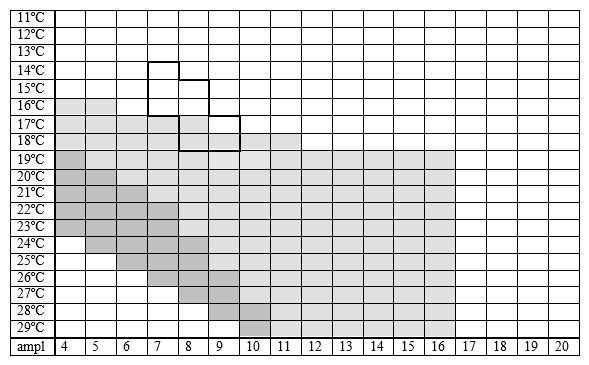
|










